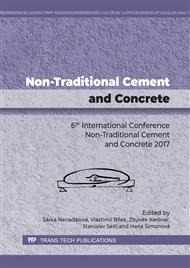[1]
De Brito, J., et al. 2005: Mechanical behaviour of non-structural concrete made with recycled ceramic aggregates, Cement and Concrete Composites, 27: 429-433.
DOI: 10.1016/j.cemconcomp.2004.07.005
Google Scholar
[2]
Hendriks, C.F., and Janssen, G.M.T. 2003: Use of recycled materials in construction, Materials and Structures, 36: 604-608.
Google Scholar
[3]
Bentur A., et al. 2001: Prevention of autogenous shrinkage in high strength concrete by internal curing using wet lightweight aggregates, Cement and Concrete Research, 31(11): 1587-1591.
DOI: 10.1016/s0008-8846(01)00608-1
Google Scholar
[4]
Suzuki, M., et al. 2009: Use of porous ceramic waste aggregates for internal curing of high-performance concrete, Cement and Concrete Research, 39: 373-381.
DOI: 10.1016/j.cemconres.2009.01.007
Google Scholar
[5]
Domski, J. 2015: Long-term study on fibre reinforced fine aggregate concrete beams based on waste sand, Rocznik Ochrona Środowiska, 17: 188-199.
Google Scholar
[6]
Ponikiewski, T., and Gołaszewski, J. 2015: X-Ray Investigation and Modelling of Steel Fibres in Self-Compacting Concrete, Transactions of the VŠB – Technical University of Ostrava Civil Engineering Series, No. 2, Vol. 15, paper #20.
DOI: 10.1515/tvsb-2015-0020
Google Scholar
[7]
Katzer, J. 2008: Properties of Precast SFRCC Beams Under Harmonic Load, Science and Engineering of Composite Materials, 15 (2): 107-120.
DOI: 10.1515/secm.2008.15.2.107
Google Scholar
[8]
Łapko, A., and Grygo, R. 2014: Effectiveness of the use of recycling aggregate concrete for sustainable building structures, Rocznik Ochrona Środowiska, 16: 627-638.
Google Scholar
[9]
Domski, J., et al. 2012: Load-CMOD Characteristics of Fibre Reinforced Cementitious Composites Based on Waste Ceramic Aggregate, Rocznik Ochrona Srodowiska, 14: 69-80.
Google Scholar
[10]
Johnston, C.D. 2001: Fibre reinforced cements and concretes, Gordon and Breach Science Publishers, Amsterdam.
Google Scholar
[11]
Maidl, B.R. 1995: Steel fibre reinforced concrete, Ernst & Sohn, Berlin.
Google Scholar
[12]
EN 14651: 2005: Test method for metallic fibered concrete – Measuring the flexural strength (limit of proportionality (LOP), residual).
DOI: 10.3403/30092475
Google Scholar
[13]
Melasa, M., and Kujawska M. 2012: Modified two-dimensional digital image correlation method with capability of merging of data distributed in time, Applied Optics, vol. 51, no. 36: 8641-8655.
DOI: 10.1364/ao.51.008641
Google Scholar
[14]
Melasa, M., and Kujawska M. 2013: Deformation measurements by digital image correlation with automatic merging of data distributed in time, Applied Optics, vol. 52, no. 19: 4681-4692.
DOI: 10.1364/ao.52.004681
Google Scholar
[15]
Piekarczuk, A., et al. 2012: Application of Hybrid FEM-DIC Method for Assessment of Low Cost Building Structures, Experimental Mechanics, vol. 52: 1297-1311.
DOI: 10.1007/s11340-012-9616-2
Google Scholar
[16]
Cichocki, K., et al. 2014: Impact resistant concrete elements with nonconventional reinforcement, Rocznik Ochrona Środowiska, 16 (part 2): 1-99.
Google Scholar
[17]
EN 933-1: 2012: Tests for geometrical properties of aggregates. Determination of particle size distribution. Sieving method.
DOI: 10.3403/01236185
Google Scholar
[18]
Katzer, J. 2012: Median diameter as a grading characteristic for fine aggregate cement composite designing, Construction and Building Materials, 35: 884-887.
DOI: 10.1016/j.conbuildmat.2012.04.050
Google Scholar
[19]
Bentur, A., and Mindess, S. 2007: Fibre Reinforced Cementitious Composites, Modern Concrete Technology Series, Taylor & Francis, London and New York, second edition.
Google Scholar
[20]
Domski, J. 2016: A blurred border between ordinary concrete and SFRC, Construction and Building Materials, 112: 247-252.
DOI: 10.1016/j.conbuildmat.2016.02.205
Google Scholar
[21]
Zollo, R. F. 1997: Fiber-reinforced concrete: an overview after 30 years of development, Cement and Concrete Composites, vol. 19: 107-122.
DOI: 10.1016/s0958-9465(96)00046-7
Google Scholar
[22]
EN 14889-1: 2006: Fibres for concrete. Steel fibres. Definitions, specifications and conformity.
DOI: 10.3403/30110332u
Google Scholar
[23]
EN 197-1: 2011: Cement. Composition, specifications and conformity criteria for common cements.
Google Scholar
[24]
EN 1008: 2002: Mixing water for concrete. Specification for sampling, testing and assessing the suitability of water, including water recovered from processes in the concrete industry, as mixing water for concrete.
DOI: 10.3403/02609198
Google Scholar
[25]
EN 12350-4: 2009: Testing fresh concrete. Degree of compactability.
Google Scholar
[26]
EN 12390-3: 2009: Testing hardened concrete. Compressive strength of test specimens.
Google Scholar
[27]
EN 12390-6: 2009. Testing hardened concrete. Tensile splitting strength of test specimen.
Google Scholar
[28]
Bayramov F., et al. 2004: Optimalisation of steel fibre reinforced concretes by means of statistical response surface method, Cement and Concrete Composites, 26(4): 665-675.
DOI: 10.1016/s0958-9465(03)00161-6
Google Scholar
[29]
JCI-SF6: 1984: Method of test for shear strength of fibre reinforced concrete.
Google Scholar
[30]
Model Code 2010: fib Bulletin 55.
Google Scholar


